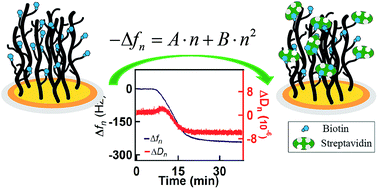A quartz crystal microbalance (QCM) and surface plasma resonance (SPR) are two typical solid-phase based technologies for biomolecular interaction studies. Although QCM is more affordable than SPR, the popularization of QCM as a biosensor is limited by the nonideal behavior that complicates the quantitative interpretation of frequency changes, especially the viscoelastic factor, implying that caution should be taken in interpreting QCM responses for large molecular applications. A poly(ethylene glycol) based matrix (PEG matrix) was tested on both QCM and SPR using model bait–prey pairs. Based on the dissipation monitoring technique, this matrix was found to have minimal viscoelasticity change before and after biomolecular binding. Furthermore, impedance analysis of frequency responses at multiple overtones was able to remove the viscoelastic contribution based on experimental results. Therefore, it is proved that the PEG matrix combined with the equations for impedance analysis of frequency changes at multiple overtones will facilitate the popularization of QCM as a biosensor.
